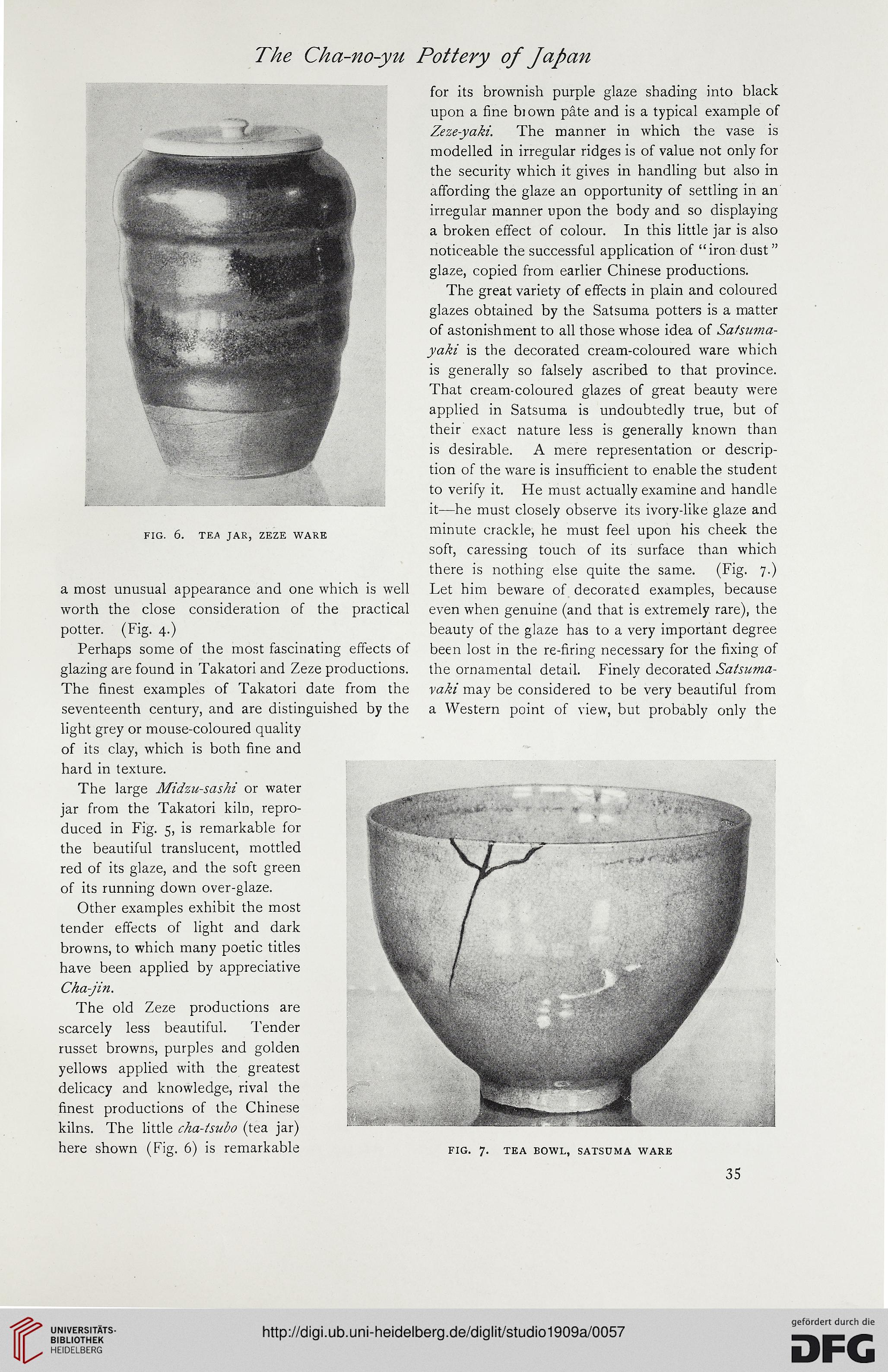The Cha-no-yu Pottery of Japan
for its brownish purple glaze shading into black
upon a fine biown pate and is a typical example of
Zeze-yaki. The manner in which the vase is
modelled in irregular ridges is of value not only for
the security which it gives in handling but also in
affording the glaze an opportunity of settling in an
irregular manner upon the body and so displaying
a broken effect of colour. In this little jar is also
noticeable the successful application of “iron dust”
glaze, copied from earlier Chinese productions.
The great variety of effects in plain and coloured
glazes obtained by the Satsuma potters is a matter
of astonishment to all those whose idea of Satsuma-
yaki is the decorated cream-coloured ware which
is generally so falsely ascribed to that province.
That cream-coloured glazes of great beauty were
applied in Satsuma is undoubtedly true, but of
their exact nature less is generally known than
is desirable. A mere representation or descrip-
tion of the ware is insufficient to enable the student
to verify it. He must actually examine and handle
it—he must closely observe its ivory-like glaze and
minute crackle, he must feel upon his cheek the
soft, caressing touch of its surface than which
there is nothing else quite the same. (Fig. 7.)
a most unusual appearance and one which is well Let him beware of decorated examples, because
worth the close consideration of the practical even when genuine (and that is extremely rare), the
potter. (Fig. 4.) beauty of the glaze has to a very important degree
Perhaps some of the most fascinating effects of been lost in the re-firing necessary for the fixing of
glazing are found in Takatori and Zeze productions. the ornamental detail. Finely decorated Satsuma-
The finest examples of Takatori date from the vaki may be considered to be very beautiful from
seventeenth century, and are distinguished by the a Western point of view, but probably only the
light grey or mouse-coloured quality
of its clay, which is both fine and
hard in texture.
The large Midzu-sashi or water
jar from the Takatori kiln, repro-
duced in Fig. 5, is remarkable for
the beautiful translucent, mottled
red of its glaze, and the soft green
of its running down over-glaze.
Other examples exhibit the most
tender effects of light and dark
browns, to which many poetic titles
have been applied by appreciative
Cha-jin.
The old Zeze productions are
scarcely less beautiful. Tender
russet browns, purples and golden
yellows applied with the greatest
delicacy and knowledge, rival the
finest productions of the Chinese
kilns. The little cha-tsubo (tea jar)
here shown (Fig. 6) is remarkable
FIG. 6. TEA JAR, ZEZE WARE
35
for its brownish purple glaze shading into black
upon a fine biown pate and is a typical example of
Zeze-yaki. The manner in which the vase is
modelled in irregular ridges is of value not only for
the security which it gives in handling but also in
affording the glaze an opportunity of settling in an
irregular manner upon the body and so displaying
a broken effect of colour. In this little jar is also
noticeable the successful application of “iron dust”
glaze, copied from earlier Chinese productions.
The great variety of effects in plain and coloured
glazes obtained by the Satsuma potters is a matter
of astonishment to all those whose idea of Satsuma-
yaki is the decorated cream-coloured ware which
is generally so falsely ascribed to that province.
That cream-coloured glazes of great beauty were
applied in Satsuma is undoubtedly true, but of
their exact nature less is generally known than
is desirable. A mere representation or descrip-
tion of the ware is insufficient to enable the student
to verify it. He must actually examine and handle
it—he must closely observe its ivory-like glaze and
minute crackle, he must feel upon his cheek the
soft, caressing touch of its surface than which
there is nothing else quite the same. (Fig. 7.)
a most unusual appearance and one which is well Let him beware of decorated examples, because
worth the close consideration of the practical even when genuine (and that is extremely rare), the
potter. (Fig. 4.) beauty of the glaze has to a very important degree
Perhaps some of the most fascinating effects of been lost in the re-firing necessary for the fixing of
glazing are found in Takatori and Zeze productions. the ornamental detail. Finely decorated Satsuma-
The finest examples of Takatori date from the vaki may be considered to be very beautiful from
seventeenth century, and are distinguished by the a Western point of view, but probably only the
light grey or mouse-coloured quality
of its clay, which is both fine and
hard in texture.
The large Midzu-sashi or water
jar from the Takatori kiln, repro-
duced in Fig. 5, is remarkable for
the beautiful translucent, mottled
red of its glaze, and the soft green
of its running down over-glaze.
Other examples exhibit the most
tender effects of light and dark
browns, to which many poetic titles
have been applied by appreciative
Cha-jin.
The old Zeze productions are
scarcely less beautiful. Tender
russet browns, purples and golden
yellows applied with the greatest
delicacy and knowledge, rival the
finest productions of the Chinese
kilns. The little cha-tsubo (tea jar)
here shown (Fig. 6) is remarkable
FIG. 6. TEA JAR, ZEZE WARE
35




